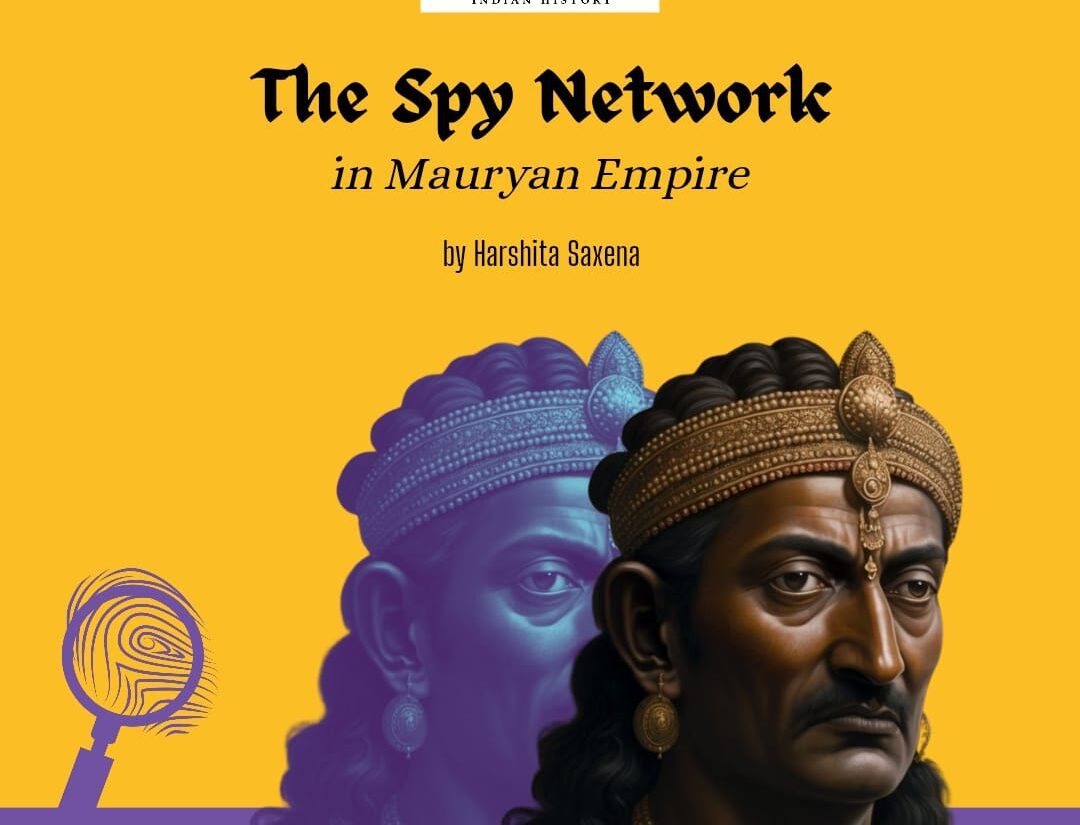
Indic Roots to Espionage
Don’t we all love to watch a spy-thriller movie while gasping at every mystery that is being solved, only to feel the rush of exclaiming, “Mission Accomplished!” Well, it’s not something that has gained vogue recently, but this thrilling, dangerous, and intellectual system dates back to the Vedic age.
The ancient Indian text, Rig Veda (RV) (1500-1000 BCE) contains references to spies, equivalent to ‘spasa’ or ‘spash’ in Sanskrit, who were sweet-spoken and anti-social, intending to protect the masses and oust the wicked, making them an integral part of the statecraft. Here, the idea might have originated as a self-defense mechanism against the unknown, making it one of the oldest professions of the ancient world. Even the Vedic god Indra, used to gather information about the Swargalok from his intelligence network when anything went south.
 The Vedic god Indra, used to gather information about the Swargalok from his intelligence network when anything went south
The Vedic god Indra, used to gather information about the Swargalok from his intelligence network when anything went south
The Hindu epics mention the extensive spy network. Ravana’s spies are mentioned as pratyayika or faithful, sura or heroic, dhira or unperturbed, and asadhvasa or fearless. According to Mahabharata, the spies should resemble the physical stature of an imbecile, a blind or a deaf person, and have the ability to tolerate hunger, thirst, and diligence.

According to Mahabharata, the spies should resemble the physical stature of an imbecile, a blind or a deaf person, and have the ability to tolerate hunger, thirst, and diligence.
The phrase “spies are king’s eyes” was well established through Manusmriti. In ancient Indian polity, an ambassador was known as ‘prakasacara’, i.e. a declared spy, as mentioned by Manu, and described five classes of spies with their various guises, who were responsible for the detection of crimes, keeping watch over the performance of officials, and determining the strength of a king and that of his enemies.
Under the Mauryan empire, it was Chandragupta Maurya who deployed an extensive espionage system under his minister, Vishnugupta, who went by the name Chanakya or Kautilya. To maintain a stable administration in an empire which “was about twice as large as Rome under Emperor Marcus Aurelius,” Kautilya wrote the Arthasastra, the most comprehensive treatises on politics in Indian Vedic Civilization.
This ancient Indian system continued even under the Guptas and Khiljis. We know that Alauddin Khilji, to control the market prices, appointed children as spies, who were sent to the market to check if the vendors were manipulating the weights and selling the products at a higher price. The espionage network continues till date and is an essential need of the countries in a globalized world, where corruption, terrorism, and other crimes are at their zenith, and thus we have RAW, ISI, etc.
Mauryan Administration: The Institution Of Espionage
In Arthasastra, Kautilya elaborated the Rajamandala (international relations) theory of the Rigveda in the Mauryan administration to include four types of strategies (niti or upayas) in domestic and foreign relations, namely, sama (conciliation); dama (procuring loyalty by money, gift, bribe or other means); danda (by force, punishment or armaments); and bheda (divide and rule). Under one such nitis, the institution of espionage finds its place. These spies were all created by the king and assisted by a council of ministers.

In Arthasastra, Kautilya elaborated the Rajamandala (international relations) theory of the Rigveda in the Mauryan administration to include four types of strategies (niti or upayas) in domestic and foreign relations, namely, sama (conciliation); dama (procuring loyalty by money, gift, bribe or other means); danda (by force, punishment or armaments); and bheda (divide and rule).
Rediscovered circa 16th century Arthashastra manuscript in Grantha script from the Oriental Research Institute (ORI) which was found in 1905
The espionage was based on three objectives: reporting, covert operations, and ascertaining the loyalty of civil servants, for the Mauryan empire to expand and prosper. These spies of the Mauryan empire could put on the garb of any profession/identity that existed under the sun, ranging from eunuch, tantric, goldsmiths, to merchants or ministers. The organizational structure for this purpose was divided into two- fixed spies (samstha) and wandering spies (sancara). The first category was usually stationed in other kingdoms, dubious areas, and forested areas, primarily to gather information under the guise of civilians. The second category, on the contrary, was used for more aggressive purposes and was accomplished in science, the use of poisons, combat, and impersonating; the kind of ones we usually see in movies and dramas.
Samstha were further classified, depending on the form of the guise they undertook- student spies (kapatika), recluses (udasthita), householders (grhapatika), merchants (vaidehaka), ascetics (tapasa), colleagues/classmates (satri), fire-brands (tiksna), poisoners (rasada) and mendicant (bhiksuku). We get references to Kautilya himself disguising himself as a mendicant/ beggar and predicting that the siege undertaken by Chandragupta Maurya would be lifted if people removed the idols from a temple. While the masses were busy in the work and rest rejoicing, the army of the Mauryas attacked and conquered. Now, these different spies had different functions to undertake, for instance, householder spies ascertained the fair collection of taxes and the fair accounting of villagers’ lands. Other than this, samstha were also used to determine the ministers’ disposition and other members of the king’s council. This was done through four tests, as established by Kautilya. The first one entailed a test of artha or greed, where the spy would entice a minister to murder the king and acquire immense wealth; secondly, a test of fear/bhaya, thirdly, a test of virtue/dharma; and lastly the test of lust/kama, where the woman-spy would allure a minister. The Mauryan administration also required fixed spies to make sure that the heir to the throne did not fall into wrong habits. To say, if the prince turned to unethical means, like getting involved with various women or becoming an alcoholic, the spies would scare him off through fraudulent ways.
Sancara were as well categorized into 4 types- orphans who depended on the state (samsargavidyasatrinah), bravados willing to risk their lives (tiksna), widows, ascetic women (parivrajika), and poisoners (rasada). These spies were sent to different kingdoms to collect information about their affairs. The tale of Misrakesi, a woman-spy disguised as a courtesan (nartaki) to avenge the death of her sister, Sukesi, who herself was a spy, and helped in destroying the Mauryan empire military enemy, Paurav, is one popular tale of a sancara. Circumstances made her join the Gupt Varangana Sena of Magadha administration, a secret army of warrior women, acting as a moving agent in the secret service of the empire with a salary of 1500 karshapana (silver coins). Her purpose was to work in close cooperation with the Nagarik Suraksha and Guptchar Vibhag, a feared spy department of Magadha whose reach was from the palaces of the rich merchants to the fields of the farmers and the dice of the gambling dens. Now, Kautilya writes that neither the institutes of espionage nor they (sancara) shall know each other.

Cover of the book , ‘Urnabhih’, tracing the story of the women-spy Misrakesi.
Internal policing aside, spies were used in war to defeat enemies. According to Kautilya, “an assassin, single-handed, does the work of a whole army or more.” One such method was through misinformation, for instance in Mahabharata, the killing of Dronacharya was done through spreading rumors of the death of his son by Drshtdumna, whereas the actual fact was that an elephant of the same name had been killed. This was done to weaken the morale of the opponent.
Conclusively, of the 150 parts that make up this document, over 50 of them have references to espionage and use of the spies in the Mauryan administration. Arthasastra is often compared to Machiavelli’s ‘The Prince’, and Max Weber said: “Truly radical Machiavellianism is classically expressed in the Arthasastra of Kautilya: compared to it, Machiavelli’s The Prince is harmless!”
Current Relevance of Arthasastra’s National Security System
Arthasastra is considered the ‘Bible of Indian political philosophy’ and the political teachings (dandaniti) mentioned in it have been used immensely by the Indian leaders, be it in the internal or international policies, as also argued by Shyam Saran in his book, ‘From Kautilya to Modi.’ In recent history, the demolition of the Babri mosque and the building of the Ram Temple are perfect examples of the BJP’s commitment to the religious extremist ideology of Hindutva. These realities are parallel to the concept of the basis of good governance according to the Arthashastra, as Kautilya clearly states that a powerful state protects its Dharma (religion based on Vedas) at any cost. Scholars like Muhammad Saad and Prof.Liu Wenxiang argued that the idea of maintaining a friendship with friendly neighbors and enmity with enemy states like in the case of Pakistan and China, the Indian foreign policy shows a clear homogeneity with Rajamandala’s theory of Arthashastra.

Arthasastra is considered the ‘Bible of Indian political philosophy’ and the political teachings (dandaniti) mentioned in it have been used immensely by the Indian leaders, be it in the internal or international policies, as also argued by Shyam Saran in his book, ‘From Kautilya to Modi.
Similarly, they opined that the teachings of espionage are parallel to one of the tensions that were raised (the arrest of a RAW agent, Kalbhushan Yadav in Pakistan) between India and Pakistan. Thus, An ex- Indian national security advisor, Shiv Shankar Menon argued that ‘the study of Arthasastra is one of the significant ways in which India can become more self-conscious about the strategic culture that exists in India and to which Indian intelligentsia can contribute to its evolution.’
REFERENCES
BOOKS
Shamasastry, R. Kautilya’s Arthashastra.
Ojha, S.Verma. Urnabhih: A Mauryan Tale of Espionage, Adventure and Seduction. India Ink, 2017. https://www.goodreads.com/book/show/23386893-urnabhih
ARTICLES
Saad, Muhammad and Wenxiang, Prof. Liu. “National Security in Kautilya’s Arthashastra: A Content Analysis”. Journal of Humanities and Education Development, Vol 2, Issue 2, 2020.
Ghosh, Prof. Suchandra and Roy, Tanmoy. “Espionage System in Ancient India”.
Abbas, Dr. Mazhar and Zahoor, Dr M. Abrar. “ Espionage in ancient India”. May 16, 2021.
Shrivastav, Tushar. “The Importance of the Spies in Ancient Indian Diplomacy”. 2015.
WEBSITES
https://saisreview.sais.jhu.edu/the-indic-roots-of-espionage-lessons-for-international-security/
IMAGES
https://encrypted-tbn0.gstatic.com/images?q=tbn:ANd9GcR4N_up2BxY2m4-qDrz7mVl7j5PDBGvDq9ICup_LnWVR0dT5n1NLFG47AXWN3Jxx9C08DA&usqp=CAU
https://images-na.ssl-images-amazon.com/images/S/compressed.photo.goodreads.com/books/1413551701i/23386893.jpg
- May 15, 2024
- 6 Min Read























